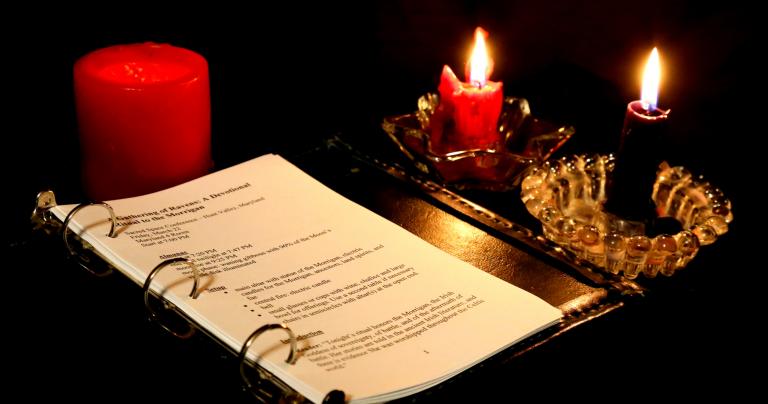Last week someone asked me for tips on speaking in ritual. I started to answer, then I realized there was more than could be covered in a quick message. And if one person is asking the question, others are probably thinking it.
I’m not a natural public speaker. I have some talent for writing, but when it comes to speaking everything you hear is the result of years of deliberate practice. I got started because my desire to lead rituals was greater than my fear of speaking in public. I’ve been leading public ritual for 17 years and I’ve learned a few things along the way. This year I’ve had to learn how to lead online rituals.
These are my suggestions for anyone who wants to do a better job of speaking effectively in ritual.

Better to read well than to memorize poorly
There is nothing more powerful than hearing good liturgy spoken smoothly and effortlessly from memory.
And there is nothing weaker than hearing someone stumble over lines they thought they had memorized but really didn’t.
If you use the same liturgy over and over again, eventually you’ll memorize it. Or, if you have the skills of an actor, you can memorize the ritual script every time. Most people don’t have those skills, but most people can read at least adequately.
It’s better to read well than to memorize poorly.
Don’t just read – perform
Most ministers I know read their sermons. The less effective ones read them like they’re reading the newspaper. The better ones don’t just read – they perform. Ritual is sacred theatre.
Put some emotion in your delivery. You’re reading an invocation? Put reverence in your voice. You’re reading a hymn or poem to a deity? Express wonder and awe with your voice.
The easiest way to learn how to do this is to hear other people do it. Listen to the invocations in the Under the Ancient Oaks Samhain Ritual. Then go find other religious speakers and ritual leaders: Pagan, Christian, or anything else. Listen for how they don’t just speak, they perform.
Put your script in a binder
Once you decide to read rather than to memorize, there are more things you can do to make your delivery flow smoothly and effectively. One of the simplest is to put your script in a binder.
Flipping pages stapled together looks amateurish. Shuffling loose papers or cards is even worse. Put your script in a binder. Not only does it look better, it makes it easier to follow along and be ready for your next line.
Binders are cheap, and they can be reused over and over again for years. I prefer the half sized binders (5½”x 8½”). They’re easier to handle, and while you can’t really see the difference on screen, in person the smaller size makes a difference.
I have a few friends who put their scripts on their Kindles – I’ve seen ministers do that with sermons and wedding scripts. I prefer paper in binders, but this works for them, and you can’t tell the difference unless you’re right in front of them.
Highlight your parts
One of the downsides to reading from a script is that other ritual leaders tend to read along. This isn’t good. If you’re not speaking, you should be looking at the speaker, at the other participants, at the altar, or doing something else that models the behavior you want to encourage from everyone else.
We tend to want to read along so we know when our next line is coming. But if you’ve practiced a bit you should have a good idea when that is. Then the only question is finding your lines on the page.
So highlight them. When you do, you’ll glance down at the page, your eyes will immediately go to the highlighted section, and you’ll start reading there. Plus that greatly reduces the chance that you’ll read stage instructions or something else that needs to be in the script but isn’t supposed to be read out loud.
Practice the ritual
The most effective way to improve your speaking in ritual is to practice. It’s also the most effective way to improve your rituals in every aspect.
Ritual is sacred theatre – rehearse! Read through your own parts multiple times. That way you get comfortable with your lines and you can look up from time to time, rather than keeping your eyes on the page all the time. This is especially important in video rituals.
If you’re doing group ritual, practice with the whole group. Know who’s doing what, who’s saying what, when you need to come in, and when you need to wait before speaking. As a rule, don’t start speaking until the person in front of you has delivered their lines, completed their actions, and returned to their place.
Use your outdoor voice
From childhood we’re told “be quiet.” “Don’t yell.” “Use your indoor voice.”
There are good reasons for these instructions (and some bad reasons too) but in ritual you need to be loud. Reading blandly is bad, but reading blandly and softly is worse.
Use your outdoor voice. Ritual isn’t a conversation – it’s a performance. You need to be heard by the people on the other side of the circle.
Slower and louder
Another mistake people tend to make – particularly when they’re nervous – is that they read faster. That makes them hard to follow.
Slow down. Speak each word precisely and deliberately.
Practice speaking
It’s important to practice the ritual before you do it for real. But if you want to get really good at speaking in ritual, you need to practice speaking outside of ritual.
There’s only so much I can explain in writing. Here’s a brief video to let you hear what I’m talking about. In this clip, I read the same invocation three times: with my ordinary voice, to perform the invocation, and to project to the back row. No editing tricks – I’m using the same settings for all three readings.
A strong voice isn’t appropriate for every part of every ritual. A guided meditation needs a soft, comforting tone… while still being loud enough to hear. Words of mourning – whether in ordinary rituals or in funerals – need a tone of sadness. Pick the approprate tone for the situation. But don’t just read – perform.
Pay attention to acoustics and background noise
I started to shoot this outdoors, where I’ve done most of my online rituals. But one of my neighbors was making a lot of noise and it would have been distracting. So I shot it indoors.
If you’re doing a small group ritual in someone’s living room, acoustics aren’t very important. If you’re leading a large ritual in a public park, they make a lot of difference. And if you’re doing a video ritual, they’re even more important. People will tune out all but the most intrusive background noise in person, but even a small noise will be a distraction on video.
Tips for video
Most of what makes in-person rituals good also applies to video and other online rituals. But there are a few extra things to remember when you’re doing a video ritual, whether it’s recorded in advance or done live on Zoom or some other platform.
Get closer to the microphone. Sound power is a square function. That means if you move 2x farther away from the microphone, the sound goes down 4x. Move 3x farther away and the sound goes down 9x. You can boost it in editing, but that’s never as clear recording loudly the first time.
Move the microphone closer to you. Maybe you don’t have the budget to buy a lapel mic for everyone in your ritual, but you can hide a phone on the altar and record the sound separately. Then match it up to the video.
Minimize background noise. Again, this is really important for video rituals. Indoors is best. If you’re outdoors, find a spot where it’s lower. If you can afford a directional microphone, that will reduce the sound coming from the sides – that’s what I use for my rituals and classes. Of course, that means you have to speak into the microphone – if you’re behind the mic or to its side, it’s not going to pick you up as clearly.
Speaking effectively in ritual is simple even if it isn’t easy. Listen to other people. Mimic the ones who sound good. Avoid the ones who sound bad. And practice, practice, practice.


















